Noise reduction device
Silencer refers to the use of noise reducing devices such as pipes and elbows with sound-absorbing lining or pipes with sudden changes in cross-sectional area and other discontinuous acoustic impedance to attenuate or reflect back the noise inside the air flow pipeline that simultaneously transmits noise. The former is called a resistive muffler, the latter is called a resistive muffler, and there are also impedance composite silencers.
Chinese name Silencer Foreign name Silencer Material carbon steel or stainless steel Function to eliminate aerodynamic noise Types of resistance silencers and resistance silencers Selection standards Noise reduction quantity and spectrum characteristics
catalogue
1 Type
2 Structure
3 impedance type
▪ Resistive type
▪ Resistance type
4 micro perforated plates
▪ Small hole type
▪ Active
5 Principles
6 Purchasing indicators
7 Selection
8 Applicable fields
9 Product Features
10 Main categories
▪ Fan type
▪ Exhaust type
11 Steam type
▪ Boiler type
▪ Exhaust type
12 Main functions
type
There are many types of mufflers, but their sound attenuation mechanisms can be divided into six main types, namely resistive mufflers, reactive mufflers, impedance composite mufflers, micro perforated plate mufflers, small hole mufflers, and active mufflers.
structure
According to the space condition at the bottom of the car, the muffler cover can be processed into a tile shaped or rolled into a pot shaped shape. The outer cover of a pot shaped muffler is formed and occluded with a circular core rod or welded together for overall installation, and the welded components are installed into the interface. The pot shaped muffler is composed of an inner tube, a turning bend, and an intermediate bottom plate, which are then connected to the outer cover through grooves or welding.
When the bottom space of a car is complex and it is difficult to install a pot shaped muffler, a deep stretched tile shaped muffler can be used. It can be made into almost any form. The total volume of a car muffler is 8-12 times the engine displacement.
Impedance type
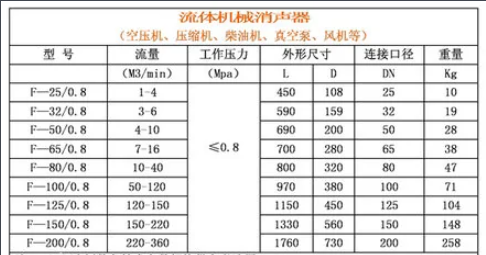

Most of the existing silencers adopt the impedance composite type silencing principle. Due to complex structure, large weight, high-temperature oxidation sound-absorbing fillers, high-speed airflow impact sound-absorbing fillers, water vapor infiltration sound-absorbing fillers, etc., silencers are prone to frequent maintenance, poor noise reduction effect, and short service life.
And this has always been a design difficulty for silencers, while micro perforated silencers have been designed based on the most reasonable silencing principles to solve the above problems and achieve good results. The micro perforated muffler does not use any resistive sound absorbing filler, and adopts a micro perforated small hole multi cavity structure. High pressure airflow enters the cavity through multiple controlled flows inside the muffler, gradually changing the sound frequency of the original airflow. Low resistance loss, wide noise reduction frequency band, and no dust during operation. Not afraid of oil mist or moisture. Resistant to high temperature and high-speed airflow impact. Ensure that environmental noise meets the national "Industrial Enterprise Noise Hygiene Standards". Widely used in industries such as petroleum, chemical, metallurgy, textiles, etc.
Resistive type
Mainly using porous sound-absorbing materials to reduce noise. Fixing sound-absorbing materials on the inner wall of the airflow channel or arranging them in a certain way in the pipeline constitutes a resistive muffler. When sound waves enter a resistive muffler, a portion of the sound energy is frictional in the pores of the porous material and converted into thermal energy consumption, which weakens the sound waves passing through the muffler. A resistive muffler is like a pure resistive circuit in electricity, and the sound-absorbing material is similar to a resistor. Therefore, people refer to this type of muffler as a resistive muffler. The resistive muffler has good noise reduction effect on medium and high frequencies, but poor noise reduction effect on low frequencies.
Resistance type
It is composed of a combination of tubes and chambers with abrupt interfaces, resembling an acoustic filter, similar to an electrical filter. Each chamber with a tube is a mesh of the filter, and the air quality in the tube is equivalent to the inductance and resistance in electricity, called sound quality and sound resistance. The volume of air in a small room is equivalent to the electrical capacitance, known as the sound conduction. Similar to electrical filters, each chamber with a tube has its own natural frequency. When sound waves containing various frequency components enter the first short tube, only certain frequencies of sound waves near the natural frequency of the first mesh can pass through the mesh and reach the second short tube mouth, while other frequencies of sound waves cannot pass through the mesh and can only be reflected back in the small chamber. Therefore, we call this structure with filtering function for sound waves an acoustic filter. By selecting appropriate pipes and chambers for combination, noise from certain frequency components can be filtered out, thereby achieving the purpose of noise reduction. Resistive silencers are suitable for eliminating medium to low frequency noise.
The combination of resistive and resistive structures in a certain way constitutes an impedance composite muffler.
Microperforated plate
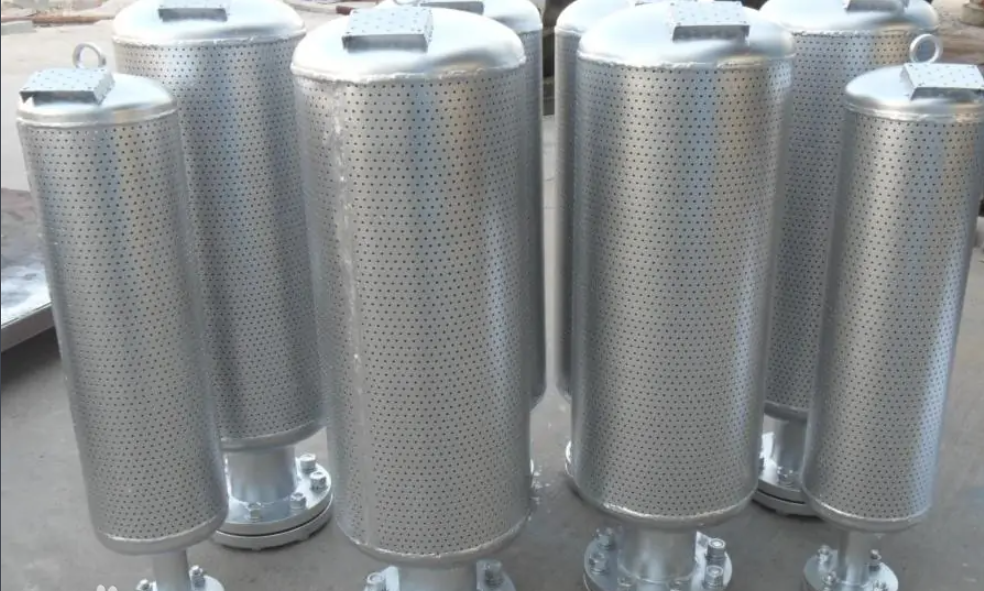
Generally, it is made of pure metal sheets with a thickness of less than 1mm, and drilled with a drill bit with a hole diameter of less than 1mm on the sheet, with a perforation rate of 1-5%. By selecting different perforation rates and cavity depths with different plate thicknesses, the spectral performance of the muffler can be controlled to achieve good noise reduction effects within the required frequency range.
Small hole type
The structure of a small hole muffler is a straight pipe with a closed end, and many small holes are drilled on the pipe wall. The principle of a small hole muffler is based on the spectrum of jet noise. If the total area of the nozzle remains unchanged and many small nozzles are used instead, when the airflow passes through the small hole, the spectrum of jet noise will shift towards high-frequency or ultra-high-frequency, significantly reducing the audible sound component in the spectrum, thereby reducing interference and harm to people.
Active
The basic principle is to use electronic devices to generate a sound wave with the same pressure and opposite phase in the original sound field, so that it can counteract the original sound field within a certain range. This type of silencer is an instrument device mainly composed of a microphone, amplifier, phase shifting device, power amplifier, and speaker.
principle
1、 The Theory of Microporous Plate Sound Absorption Structure
Pierce micropores with a pore size of 1.0mm or less on thin plates with a thickness of less than 1.0mm, with a perforation rate of 1-5%,
There is a certain thickness (5-20cm) of air layer left at the rear, which is not filled with any sound absorbing material, thus forming a micro perforated plate sound absorption structure. It is a resonant sound absorption structure with low sound quality and high sound resistance. Its research shows that the sound absorption coefficient and frequency band width that characterize the sound absorption characteristics of microperforated plates are mainly determined by the sound quality m and sound resistance r of microperforated plates, which are related to the diameter d of micropores and the perforation rate p. The relative acoustic impedance Z of the microperforated panel sound-absorbing structure (based on the characteristic impedance of air ρ Calculate with equation (1) using C as the unit:
Z=r+jwm=jctg (WD/C) (1)
In the formula:
ρ-- Air density (kg/cm3);
C - Sound velocity in air (m/s);
D - cavity depth (mm);
M - relative sound quality;
R - relative sound resistance;
W - angular frequency, W=2 π f (f is the frequency);
And r and m are respectively expressed by equations (2) and (3):
R=atkr/dzp (2)
M=(0.294) × 10-3tkm/p (3)
In the equation:
T - Plate thickness (mm)
D - aperture (mm)
P - Perforation rate (%)
Kr - Sound resistance coefficient kr=(1+x2/32) 1/2+(2x) 1/2/8 × D/t
Km - Sound quality coefficient km=1+{1+[1/(9+(x2/2))]}+0.85d/t
Where x=abf, a and b are constants, and for insulation plates a=0.147, b=0.32; For thermal conductivity plates a=0.235, b=0.21. The angular bandwidth of sound absorption is approximately determined by r/m, and the larger this value, the wider the frequency band of sound absorption. R/m=(l/d2) × (kr/km) (4)
In the formula, l - constant, for metal plate l=1140, and for insulation plate l=500. The above equation can also be expressed using equation (5):
R/m=50f ((kr/km)/x2) (5)
The approximate calculation formula for kr/km is:
Kr/km=0.5+0.1x+0.005x2 (6)
By using the above methods, the parameters of x, d, t, p, etc. of the microperforated panel sound absorption structure can be obtained from the required r, m, and f. Due to the small and sparse pore size of microperforated plates, the fundamental sound resistance r value is much larger than that of ordinary perforated plates, and the sound quality m is very small, the sound absorption frequency band is much larger than that of ordinary perforated plate resonance sound absorption structures. Generally, the sound absorption frequency band width of single-layer or double-layer microperforated plate sound absorption structures with good performance can reach 6-10 1/3 signal frequency bands or more. This is the biggest characteristic of the microperforated panel sound absorption structure.
Maximum sound absorption coefficient at resonance α 0 is α 0=4r/(1+r) 2 (7)
When designing the sound absorption structure of microperforated panels, calculations can be conducted or charts can be consulted, and the calculated results are similar to the measured results. In practical engineering, in order to expand the width of the sound absorption frequency band, double or multi-layer microperforated plate composite structures with different apertures and perforation rates are often used.
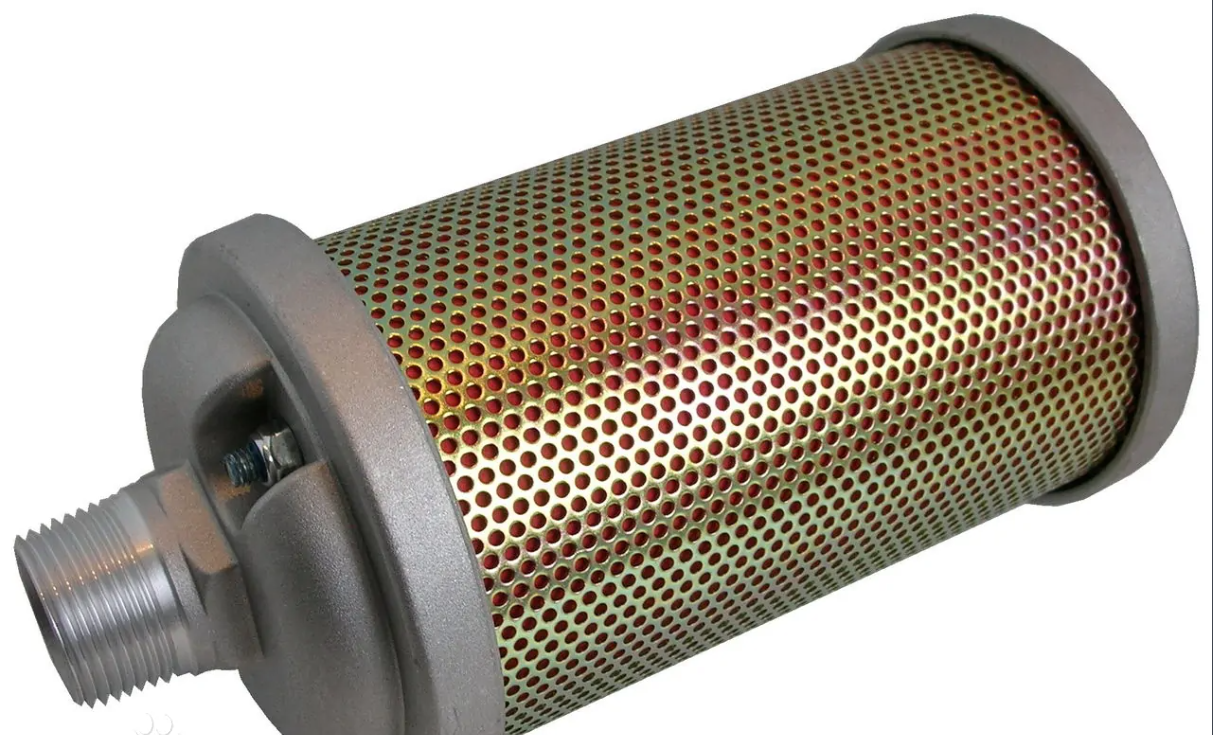
2、 The Application of Micro Perforated Plate Theory in the Design of Anti Spray Resistance Silencer
There are many types of mufflers designed and manufactured using microperforated acoustic structures, with the main type being anti spray type mufflers. This type of silencer is made of stainless steel perforated sheet. As the nine silencers are used in petrochemical units and have high air corrosion, the sound absorbing material filled in the air layer behind the perforated plate is corrosion-resistant metal soft wire cloth. By utilizing the resistive sound absorption principle of sound-absorbing materials, the effect of noise reduction and elimination can be further achieved,
Its sound absorption coefficient is high, absorption frequency band is wide, pressure loss is small, airflow regeneration noise is low, and it is easy to control. To achieve broadband and high absorption, a three-level microperforated plate structure is generally used. The size of the cavity between the microperforated plate and the shell, as well as between the microperforated plate, varies according to the frequency band that needs to be absorbed. The low-frequency cavity is larger (150-200mm), the intermediate frequency cavity is smaller (80-120mm), and the high-frequency cavity is smaller (30-50mm). The depth of the front cavity in the double-layer structure should generally be smaller than the rear cavity, and the ratio of the depth of the front and rear cavities should not be greater than 1:3. The perforation rate of the front layer of microperforated plate close to the airflow should be higher than the rear layer to reduce the impact of axial sound propagation, A transverse partition can be added every 500mm in the cavity of the micro perforated plate muffler. Experiments have shown that the measured values of the low frequency, medium frequency, and high frequency sound attenuation performance of micro perforated plate silencers are better than theoretical estimates. And the amount of noise reduction is related to the flow rate, and is not related to the temperature rise of the muffler. When the flow rate reaches 70 meters/second, other types of mufflers are generally unable to solve the noise problem, while microporous mufflers can withstand the impact of 70m/s airflow speed, and there are still mufflers above 15dB. This is also an important feature of microporous silencers that are superior to general silencers.
3、 Characteristics of anti spray resistance type muffler
This type of muffler is designed based on the most reasonable sound attenuation principle of microperforated plates, which allows high-pressure steam to enter the pressure reducing chamber for expansion after passing through a primary flow control in the muffler, forming low-pressure steam that is sprayed out from the small hole. Finally, the residual noise emitted by the pressure reducing body is effectively absorbed through a sound barrier outside the pressure reducing body, and the final muffler reaches over 35dB (the proportion between first to third level silencing is 35%, 50%, and 15%).

Purchasing indicators
To measure the quality of a muffler, the following three aspects are mainly considered:
1. The sound attenuation performance of the muffler; (Noise reduction and spectral characteristics)
2. The aerodynamic performance of the muffler; (Pressure loss, etc.)
3. The structural performance of the muffler. (Size, price, lifespan, etc.)
·The frequency characteristics of silencers. The anti spray resistance type muffler has superior effects on various frequencies of noise.
·The applicable wind speed of the muffler is generally 6-8m/s, and the maximum should not exceed 12m/s. At the same time, pay attention to the pressure loss of the muffler.
·Pay attention to the net channel cross-sectional area of the muffler. When connecting the air duct to the muffler, if necessary (when the wind speed is limited), amplification treatment should be carried out.

·Silencers and other silencing equipment must be installed with independent load-bearing suspension rods or bases; It must be connected to the sound source equipment through a soft joint.
·When two silencing elbows are used in series, the connection distance between the two elbows should be greater than 2.5 times the diagonal length of the elbow section.
·For environmental systems with high temperature, high humidity, oil mist, and water vapor, microporous structure silencing equipment is generally used. For environmental systems with cleanliness requirements such as operating rooms, recording rooms, and clean factories, microporous structure silencing equipment should be used.
·When the pipelines of adjacent rooms are interconnected, attention should be paid to the mutual influence of indoor noise through the pipelines. If necessary, the air vents should be silenced.
Selection
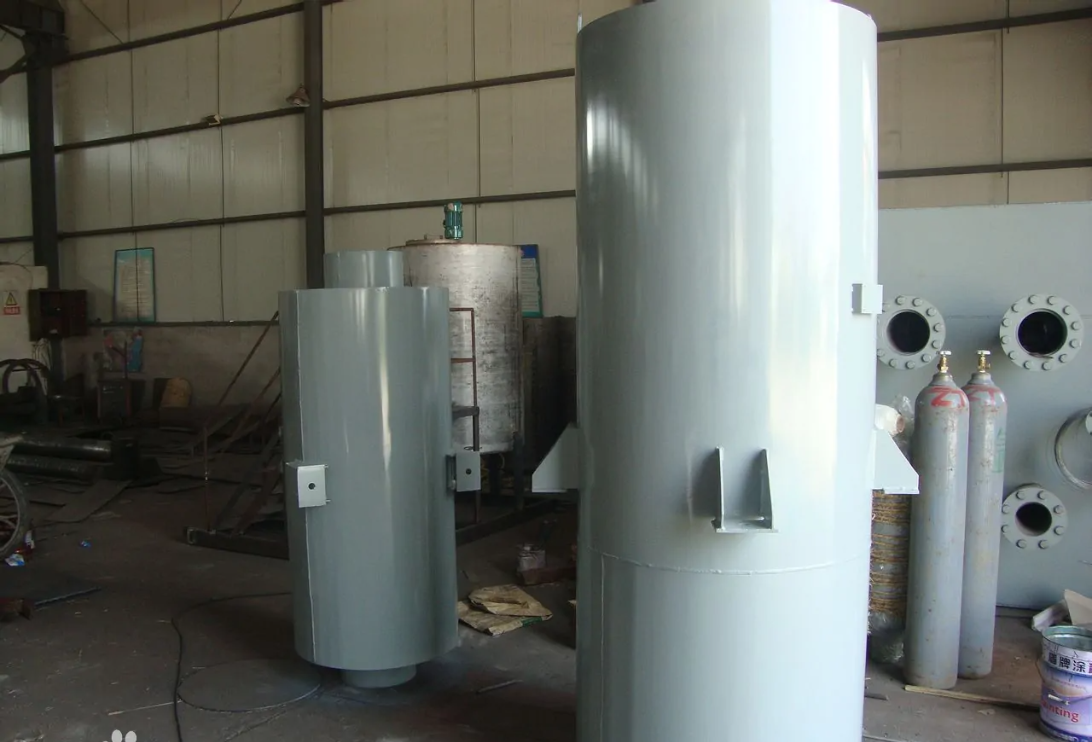
Silencers are used to reduce exhaust pulsation and minimize exhaust noise as much as possible. The selection of silencers should be based on fire, moisture, corrosion, cleanliness requirements, installation space location, noise source spectrum characteristics, natural sound attenuation of the system, air flow regeneration noise of the system, allowable noise level of the room, allowable pressure loss, equipment price, and other factors, and may be biased according to the actual situation. The general situation is that the greater the noise reduction capacity of a muffler, the greater the pressure loss and price; If the amount of noise reduction is the same, the smaller the pressure loss, the larger the space occupied by the muffler.
Applicable fields
The new high-efficiency anti spray resistance series muffler equipment is widely used in industrial factories and mines such as power generation, chemical industry, metallurgy, textile, etc. It is used for exhaust of various types of boilers and steam turbines; Fan; Silencing and noise reduction of safety doors and other equipment. This series of mufflers is developed based on the principle of composite noise reduction with resistance, spray, and resistance. It has many advantages such as large noise reduction, small volume, light weight, and easy installation without maintenance.
1. TA type steam safety valve silencer suitable for various types of steam safety valves
Suitable for safety valves of pressure devices such as power release valves, drum safety valves, superheater safety valves, reheater safety valves, etc. in power plant boilers. The steam venting should not only avoid excessive noise, but also allow the steam flow to be smoothly discharged without affecting the displacement, jumping, and reseating of the safety valve. Therefore, the commonly used methods of multi-level throttling and small hole injection for noise reduction are not suitable. This limitation has always been a design difficulty for safety valve silencers, and it is also the reason for the poor noise reduction effect of safety valve silencers. The new TA type safety valve exhaust muffler used for safety valves adopts the principle of jet impedance composite silencing, in which large hole expansion is used to replace the smaller diameter control hole, which further strengthens the resistance and resistance silencing and noise reduction mechanism in structure, achieving a higher safety coefficient of silencing and noise reduction effect.
2. TB type ignition exhaust muffler suitable for steam equipment such as boilers
The TB type boiler ignition exhaust muffler is designed based on the most reasonable sound elimination principle of the PB type exhaust (gas) muffler. High pressure steam enters the pressure reducing body after passing through a flow control in the muffler, and after being expanded and depressurized again with a large volume, it often causes exhaust noise to still exceed the standard value due to various reasons such as exhaust deviation from the design value. For this purpose, a combined multi material composite structure sound insulation and absorption cover was designed outside the pressure reducing body. The composite sound insulation and absorption cover is designed based on the spectral characteristics of the residual noise emitted by the pressure reducing body to effectively absorb the residual noise. After the user installs according to the requirements, the total noise reduction can reach 36-42 decibels.
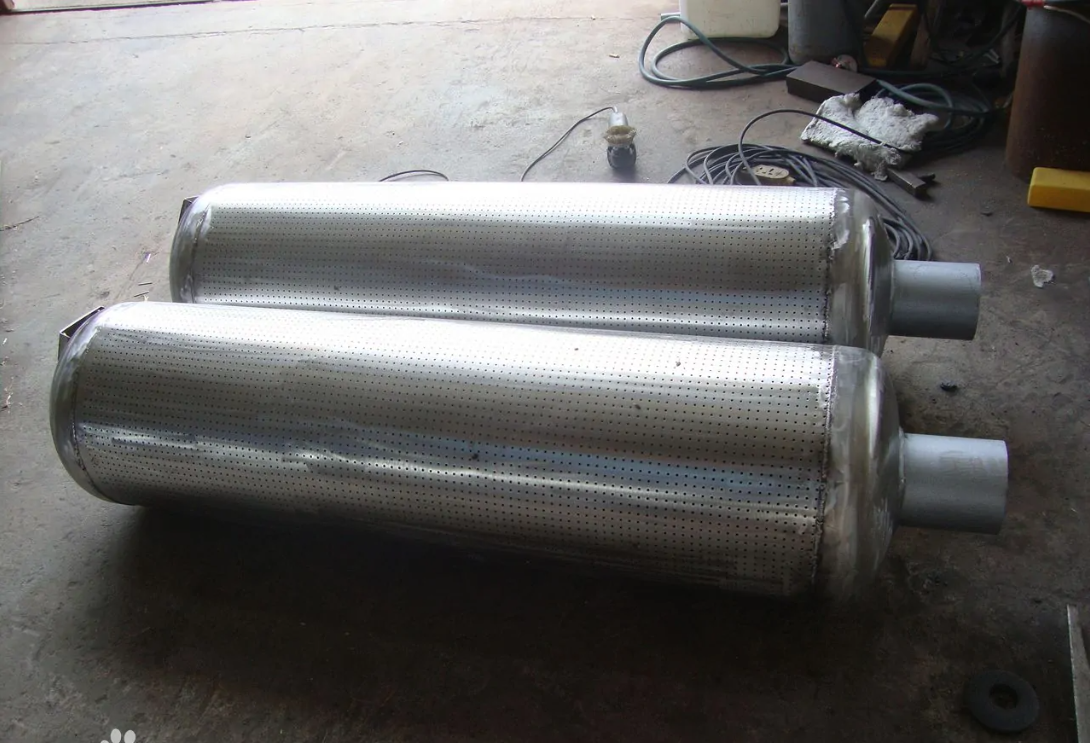
3. TD type low-pressure steam silencer suitable for various low-temperature and low-pressure thermal devices
In various industrial and mining enterprises, a large number of low-pressure boilers with a pressure of 0.13MPa or below are used. There are also a large number of low-pressure thermal devices in the power plant thermal system, such as backpressure steam turbines, deaerators, auxiliary air extractors, steam turbine oil pumps, continuous boiler blowdown, periodic blowdown, etc. The above equipment is equipped with a lightweight and more convenient muffler according to the requirements of the exhaust pipe. We have designed specialized TDb back pressure turbine exhaust silencers, TDy deaerator silencers, and other series of noise reduction products for different noise reduction objects, which can meet the requirements of users.
4. TC type flushing pipe special muffler suitable for boiler testing, purging, and industrial pipeline installation and maintenance
TC type pipeline flushing muffler is a specialized type of exhaust developed to reduce the noise generated by debris discharge and exhaust gas emissions from the flushing pipeline outlet during the commissioning and blowing of power plant boilers











